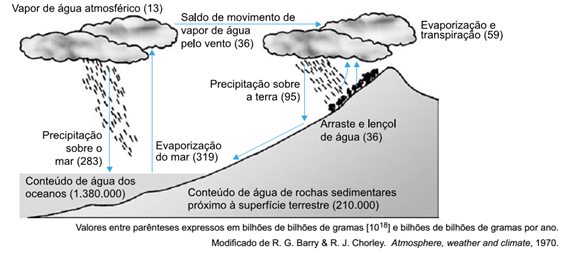Water is transported by the plant from the root to the leaves through the xylem, a conductive tissue. The water enters the plant's body through the cells of the source until reaching the xylem, which transports the substance throughout the plant's body. When it reaches the leaves, the water leaves the conductive elements and passes to the leaf mesophile. At this location, water can be eliminated from the plant body in the form of steam by the perspiration.
→ little sweating
In situations where transpiration occurs slowly or is absent, what moves water from the root to the shoot is the water potential, which is generated by the secretion of ions into the xylem. In these cases, the water potential becomes more negative, and the water, for osmosis, enters the xylem. This situation is known as positive root pressure.
→ a lot of sweating
When transpiration is intense, the roots perform passive absorption of water, which is pulled through the flow promoted by the transpiration of the leaves. This flow is explained by cohesion-tension theory
Cohesion-tension theory
According to the theory of tension-cohesion, water presents itself continuously in the body of the plant, more precisely inside the conducting vessels, maintaining a continuous movement of water from the ground to the plant and from there to the atmosphere. This upward movement of water occurs as a result of water loss by transpiration through the stomata.
Do not stop now... There's more after the advertising ;)
When transpiration occurs at the end of the xylem elements, there is a decrease in the water potential in the region due to an increase in the concentration of solutes in the cell. Saturated cells begin to gain water and, from cell to cell, this event reaches the xylem, exerting a suction. Therefore, water moves towards the lowest water potential.
As water molecules have enormous cohesion, the tension produced is transmitted from the stem region to the roots. Because of the cohesion between the water molecules and their strong adhesion to the xylem walls, a continuous column of water is formed. When removing water from the roots, it is observed that the water potential becomes more negative, causing a greater absorption of water from the soil to occur.
Therefore, it is concluded that, according to this theory, the raw sap is moved by the tension created through perspiration.. It is noteworthy that this theory can also be called the theory of cohesion, adhesion and tension, since adhesion to the walls of xylem elements is also essential to ensure the rise of water.
By Ma. Vanessa dos Santos
Would you like to reference this text in a school or academic work? Look:
SANTOS, Vanessa Sardinha dos. "Transport of water through the body of the vegetable"; Brazil School. Available in: https://brasilescola.uol.com.br/biologia/transporte-agua-pelo-corpo-vegetal.htm. Accessed on June 28, 2021.


